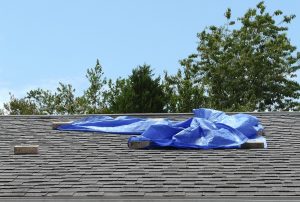Print a Sign-In Sheet | Spanish Version Coming Soon
It is common for contractors to address roof repairs following a severe storm, and often times roof tarps are placed temporarily to help minimize or prevent further damage from rain and other elements of mother nature.
Employees must access the roof to install the tarps. Thus, they are at risk of injury from things such as falls, electrocutions, and other hazards.
Please see below for safety tips when installing tarps.
Hazard Identification
- Look for downed overhead power lines & assume they are live
- Maintain 10 feet minimum distance from overhead power lines
- Generator use can cause “back feed” energizing lines that are no longer receiving power from the electrical grid
- Avoid the use of a metal ladder near power lines or energized electrical equipment
- Assess the roof condition/stability prior to allowing employees on the roof
- Prevent fall hazards by selecting and requiring employees to use a fall protection system
- Personal fall arrest system (harness with lanyard and tied off)
- Guardrail system
- Safety nets
Tarp Installation Safety
- Avoid installing tarps during a storm, wind, or rain
- Wear appropriate personal protective equipment
- Use control measures such as chutes and barricaded areas when removing roof debris to protect workers on the ground from falling object hazards
- Follow safe ladder techniques to prevent falls
- Avoid getting on the roof when work may be done from ladders or other stable platforms
- Keep an eye out for trip hazards such as vent stacks, satellite dishes, and cables/cleats holding down the tarp
- Never walk on tarps as they are slippery
- Never walk on tarps as there could be a roof opening or skylight underneath resulting in a fall hazard
KEMI does not assume liability for the content of information contained herein. Safety and health remain your responsibility. This information is to be used for informational purposes only and not intended to be exhaustive or a substitute for proper training, supervision or manufacturers’ instructions/recommendations. KEMI, by publication of this information, does not assume liability for damage or injury arising from reliance upon it. Compliance with this information is not a guarantee or warranty that you will be in conformity with any laws or regulations nor does it ensure the absolute safety of any person, place or object, including, but not limited to, you, your occupation, employees, customers or place of business.

